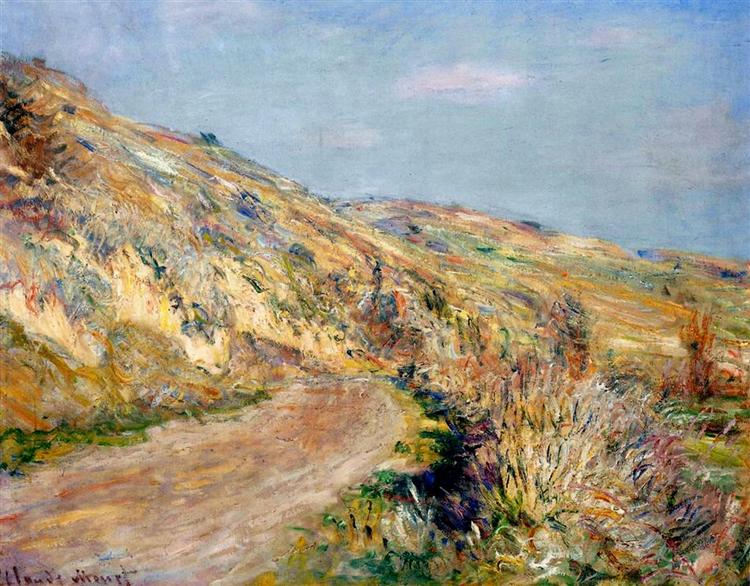Description
The painting "The Camino to Giverny" (1885) by Claude Monet is an emblematic work that encapsulates the essence of the transition of impressionism towards the full exploration of the landscapes that would stain its canvases in the future. The work, which is chronologically located in a stage where Monet had already begun to cement its unique approach to light and color, is a testimony of both its technical domain and its deep connection with nature.
The composition of the paint is marked by an almost diagonal structure that guides the viewer's gaze from the foreground to the bottom, where the soft undulations of the fields and a horizon that is lost in the sky can be glimpsed. In the foreground, a winding road is presented as the conductive axis of the work, inviting the viewer to imagine the trip to Giverny, a place that would become the home and the inspiration of Monet. On both sides of this path, lush vegetation and wild flowers explode in a vibrant color palette, reflecting the exuberance of spring and richness of the Norman landscape.
The use of color in "the way to Giverny" is notable for its audacity and subtlety. Monet uses a variety of green, yellow and blue, each applied with loose and dynamic brushstrokes that create a sense of movement and life. This color use is not merely decorative; Rather, it captures the changing luminosity of the environment, a central characteristic of the impressionist approach. Quick observations of the atmosphere and the climate are essential for the interpretation of the work, and the way Monet uses natural light contributes to the general impression of a fleeting moment over time.
Although painting does not represent explicit human figures, it suggests the presence of life through the representation of the landscape. The fields and roads that know the passage of the farmers or walkers, invoke a feeling of familiarity and connection with the community and rural life in which Monet was immersed. In addition, this absence of individual characters allows the spectator to form their personal connection with space, almost as if the road were an open symbol of possibilities.
Interestingly, "the way to Giverny" reflects not only Monet's artistic moment, but also a broader change in the perception of the landscape in French painting of the late nineteenth century. During this period, the exploration of the light, the texture, and the relationship of the human being with the natural environment charged an unprecedented relevance. Monet, as a pioneer of impressionism, challenged the academic rules of representation, thus opening the way for future generations of artists who would continue to explore these issues in new directions.
Finally, it is essential to consider the relationship of this work with other contemporary pieces of Monet and the impressionist movement in general. Comparisons can be traced with works such as "Lunch" (Luncheon) or "La Rue Montorgueil" where the focus on light, color and capture of ephemeral moments in everyday life are manifested with equal fervor. "The way to Giverny" is erected in this context as a bridge between the search for a more dynamic expression of the landscape and the vibrant world in which Monet found his home and his inspiration.
Thus, this work is not only a tribute to the splendor of Giverny, but a window to the mastery of an artist who blurred the boundaries between observation and imagination, inviting each observer to follow their way through a world where the light and color creates a visual language that resonates with a enduring force.
KUADROS ©, a famous paint on your wall.
Hand-made oil painting reproductions, with the quality of professional artists and the distinctive seal of KUADROS ©.
Reproduction service paintings With a guarantee of satisfaction. If you are not completely satisfied with the replica of your painting, we refund your money 100%.

